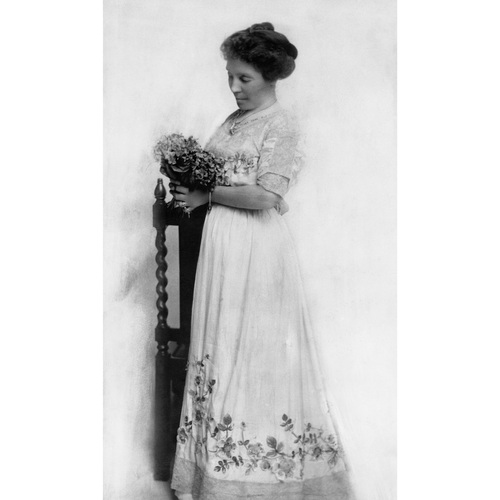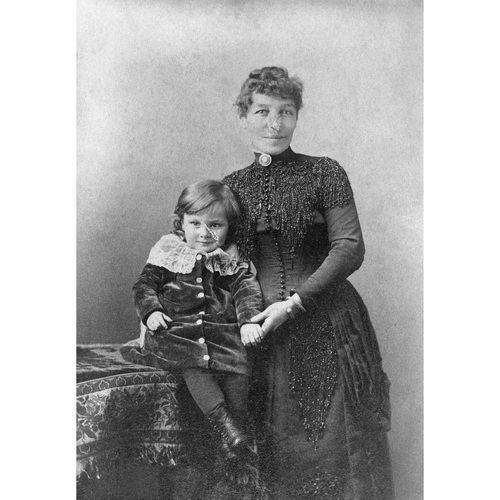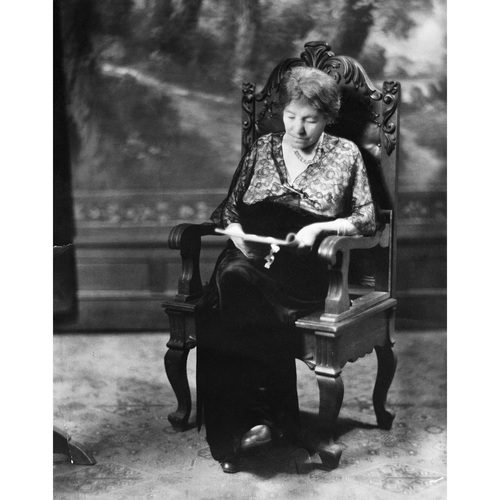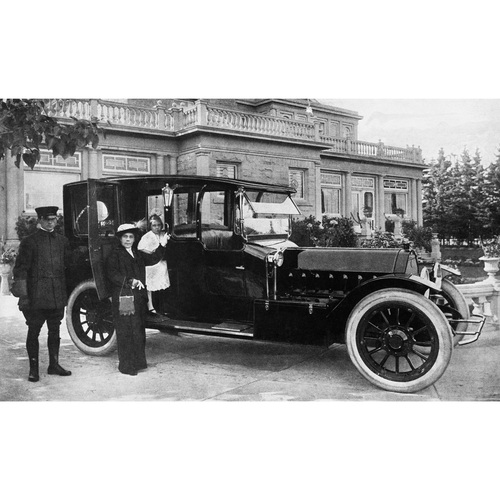![Lady Lougheed. Date: [ca. early 1900s]. Image courtesy of Glenbow Museum, Calgary, Alberta. Original title: Lady Lougheed. Date: [ca. early 1900s]. Image courtesy of Glenbow Museum, Calgary, Alberta.](/bioimages/w600.11800.jpg)
Source: Link
HARDISTY, ISABELLA CLARK (Clarke) (Lougheed, Lady Lougheed), society leader and patron of the arts; b. probably 18 April 1861 in Fort Resolution, N.W.T., daughter of William Lucas Hardisty* and Mary Anne (Ann) Allen; niece of Richard Charles Hardisty* and, by marriage, of Donald Alexander Smith*; m. 16 Sept. 1884 James Alexander Lougheed* in Fort Calgary (Calgary), and they had four sons and two daughters; grandmother of Alberta premier Edgar Peter Lougheed*; d. 13 March 1936 in Calgary.
Isabella Hardisty’s father spent his entire career with the Hudson’s Bay Company, holding the position of chief factor for the Mackenzie River district from 1868 until his retirement ten years later. Her mother had been born in the Columbia district, probably at Fort Vancouver (Vancouver, Wash.), but was raised in northern fur-trade country after she was orphaned as a young girl. Both were of European and indigenous ancestry.
Belle or Bella, as she was known, lived at home until she was approximately six years old, when she was sent to Mathilda Davis*’s school in St Andrews (Man.). As she later recalled, reaching the school involved a long expedition by York boat, on foot, and overland by covered wagon. In the course of this journey, she caught scarlet fever, and after spending some months at St Andrews, she went to stay with her paternal grandparents, Richard and Marguerite (Margaret) Hardisty, in Lachine (Montreal) while she recuperated. Between 1868 and 1875 Belle attended the Wesleyan Female College in Hamilton, Ont. The curriculum of this institution placed a special emphasis on the arts, and as well as receiving a sound academic education, she learned to paint and to play the piano and the organ [see Robert Steele Ambrose*], interests she would retain all her life. After leaving the college, she rejoined her family in the northwest. Though life was often hard, she retained fond memories of her years there, later recollecting for a journalist the “wonderful” Mackenzie River. Her mother’s northern upbringing served the family well when they survived for seven months at Fort Rae (Old Fort Rae, N.W.T.) on 50 pounds of flour and the whitefish they caught in Great Slave Lake.
When William Hardisty retired, he moved his family first to Winnipeg, where they spent the winter with Donald Smith and his wife, and then to Lachine. In 1883, two years after her father’s death, Belle went to visit her uncle Richard Hardisty in Fort Calgary. There she met lawyer James Lougheed, who had arrived in the hamlet at around the same time. They evidently became acquainted at the Methodist Church, where she played the organ and he superintended the Sunday school. The couple were married in 1884 and at first lived in a small house, originally a tailor’s shop, which James improved by installing the community’s first bay window.
Local newspapers document Belle’s contribution to Calgary’s social structure as it grew from a small settlement to an important centre of commerce and political influence in the west and her rise as its premier hostess, particularly after James was appointed to the Senate in 1889. She was president of the Ladies’ Aid of the Methodist Church and also treasurer of the Women’s Hospital Aid Society in 1890. Five years later, at a public gathering addressed by Lady Aberdeen [Marjoribanks] and other dignitaries, Belle moved the establishment of a local branch of the National Council of Women of Canada (NCWC); she subsequently served on its executive and was vice-president for the Alberta district of the NCWC from 1896 to 1898. In 1909 she became the first president of the Calgary branch of the Victorian Order of Nurses for Canada, and that year she also helped to organize the Colonel Macleod Chapter of the Imperial Order Daughters of the Empire (IODE), taking on the position of viceregent. The first and many of the chapter’s later meetings were held at her home, and she remained an honorary regent of the IODE until her death. In these endeavours she worked with like-minded women such as her friend Jean Anne Pinkham [Drever], wife of the Anglican bishop of Calgary.
Belle was a proponent of the City Beautiful movement [see John Seabury Pearce*], which swept the west in the late 1800s and early 1900s. James’s financial successes enabled the couple to build a grand mansion in 1891–92, which they named Beaulieu (now Lougheed House and a national historic site). The residence, with its manicured gardens, became the venue at which they hosted royalty and other prominent figures. Beaulieu and its visitors were often described in great detail by the newspapers and drew national attention, helping to boost the image of a sophisticated new west. In 1911 the Lougheeds entertained world-renowned violin virtuoso Mary Kathleen Parlow* when she returned to her birthplace during a North American tour.
Belle’s social skills are demonstrated by the fact that when the governor general, the Duke of Connaught [Arthur*], his wife, and their daughter visited Calgary the following year, they stayed at Beaulieu, and “contrary to the usual custom,” the Calgary News Telegram reported, the viceregal couple “requested that their host and hostess should not leave their home during the royal sojourn.” In 1919 the Lougheeds held a grand garden party in honour of the Prince of Wales on his first visit to Canada. When he returned with his younger brother Prince Albert in 1927, Belle was one of the dinner hostesses, along with the wife of James’s long-time business associate Edmund Taylor. The Lougheeds’ married daughter, Dorothy Isabel (Isabelle) Hussey, was remembered by the local press as one of the Prince of Wales’s “favorite dancing partners” when he came to the city.
Many of Calgary’s society women made regular trips to cottages that they owned in Banff, and Belle was no exception. Her arrival was often noted by the Crag and Canyon (Banff), which reported in June 1919 that Lady Lougheed, as she had become when James was knighted three years earlier, had returned to “open her Banff residence for the season.” During one visit she and her sons Clarence Hardisty and Norman Alexander caused something of a sensation. After the senator had returned to Ottawa, they and their guests, ignoring his advice, travelled to Banff by automobile. However, their triumph at arriving in the first car to enter the national park surrounding the town was soon dampened when the vehicle was impounded in accordance with park laws that prohibited such access. Undaunted, the party spent the day in the park before retrieving the car for the drive home. During her married life Belle also enjoyed many trips abroad in connection with her husband’s official duties. After one such excursion in 1923 Belle told the Morning Albertan that she had had a “most delightful time in Paris,” and she spoke of “the beautiful Bois de Boulogne and the wonderful shops they visited.” Rome, she mused, “is perfectly wonderful … I would like to live there the rest of my life,” but a visit to Naples gave her an “impression of dirt and appalling poverty.”
James Lougheed had been sufficiently influenced by Belle’s sociable nature and her love of music, theatre, and dance that he shed some aspects of his strict Methodist upbringing. Together the couple established the 1,500-seat Sherman Grand Theatre, which opened on 5 Feb. 1912 in an office block that James had erected. The Calgary Symphony Orchestra, of which Belle was a founding member, was launched at the theatre the following January, and she remained an honorary patron until her death. The Lougheed family kept a box at the Sherman Grand, where Belle could regularly be seen at musical and other events. It was at the theatre in October 1912 that the teenaged Fred and Adele Astaire introduced the still-controversial tango to Calgary audiences during a vaudeville act.
A consummate diplomat, Belle accepted many roles but rarely commented on political or feminist activism, though she once acknowledged that it would be unjust for women to lose the right to vote in municipal elections. When, in 1909, the city of Calgary proposed a by-law that would have prohibited them from doing so, she observed to the Morning Albertan: “Of course I think that married women ought to have the vote. I should think any fair-minded person would feel the same way. I always have voted and I should dislike very much to give up the privilege. It would not be fair.”
Lady Lougheed recognized the importance of the northwest’s early settlers and served as first president of the Women’s Pioneer Association of Southern Alberta when it was founded in 1922. Yet she lived at a time when racial boundaries were hardening in the west, and there is little in the extensive coverage of her activities in newspapers and journals to indicate that she identified herself as a woman of mixed ancestry. The elite society in which she moved certainly knew she had indigenous forebears. As Sylvester Clark Long, a journalist of mixed origins who called himself Chief Buffalo Child Long Lance, wrote in the Mentor in 1924, “Some of Western Canada’s best citizens are of Scotch and Indian descent. Lady Lougheed, wife of Sir James Lougheed, minister of the interior, is a half-breed.” But Belle was adept at managing her reputation and steered clear of controversial issues such as miscegenation and racism.
After James’s death in 1925, Belle stayed on at Beaulieu. Her contributions to the community were recognized in many ways, but one of the most telling is the fact that she was allowed to remain there for the rest of her life. By 1934 the city had acquired the property for non-payment of taxes, the Lougheed estate having been devastated by depressed land values in the 1920s and the proceeds of her father’s estate largely dissipated by her siblings. The municipality’s decision to permit Belle Lougheed to stay in her home enabled her to continue as first lady of the west, entertaining guests for events such as New Year’s Day celebrations just a few months before she died in March 1936. A public service at the Pro-Cathedral Church of the Redeemer after her death attracted hundreds of citizens, who turned out to honour the memory of this Calgary pioneer.
The author’s book, Metis pioneers: Marie Rose Delorme Smith and Isabella Clarke Hardisty Lougheed, was published in Edmonton in 2017.
AM, Matilda Davis School coll., box 2, file 2 (notebook); HBCA, Biog. sheets, Hardisty, William Lucas. GA, M 729 (George and John McDougall family fonds), file 74; M 2465, file 7A; M 4843-13-14; M 5908, file 1489. Lougheed House, Arch. & Coll. (Calgary), Jennifer Bobrovitz file; Lougheed family Bible; Donald Smith coll. Albertan (Calgary), 14, 17 March, 14 Nov. 1936. Calgary Herald, 17 Sept. 1884; 29 Nov. 1895; 21 March, 5 Oct. 1912; 15 Sept. 1919; 13 Aug. 1927; 17 Dec. 1932; 13, 14 March 1936. Calgary News Telegram, 7 Feb., 4 Sept. 1912. Calgary Tribune, 30 Nov. 1895. Calgary Weekly Herald and Alberta Livestock Journal, 6 Jan. 1892. Globe, 17 Oct. 1891. Morning Albertan (Calgary), 21 Oct. 1907, 28 Oct. 1909, 3 May 1923. E. B. Price, “Alberta’s women pioneers will form organization,” Calgary Herald, 21 March 1922: A1–A2. Canadian Women’s Press Club, Calgary Branch, The Calgary Club woman’s blue book (Calgary, 1915). Central United Church, Calgary, They gathered at the river, 1875–1975, ed. J. F. Perry (Calgary, 1975). Madeleine Johnson, “Lady Isabella Lougheed” (typescript, 1996; copy in the Lougheed House, Arch. & Coll.). Buffalo Child Long Lance [S. C. Long], “Indians of the northwest and west Canada,” Mentor (New York), 12, 2 (March 1924): 1–40. Marjorie Norris, A leaven of ladies: a history of the Calgary Local Council of Women (Calgary, 1995). [E. B. Price], “Canadian women in the public eye: Lady Lougheed,” Saturday Night, 16 Sept. 1922: 27. D. B. Smith, Calgary’s Grand story: the making of a prairie metropolis from the viewpoint of two heritage buildings (Calgary, 2005). Wesleyan Female College, Annual catalogue (Hamilton, Ont.), 8 (1868/69)–14 (1874/75).
Cite This Article
Doris Jeanne MacKinnon, “HARDISTY, ISABELLA (BELLE) CLARKE (Lougheed),” in Dictionary of Canadian Biography, vol. 16, University of Toronto/Université Laval, 2003–, accessed December 22, 2025, https://www.biographi.ca/en/bio/hardisty_isabella_clarke_16E.html.
The citation above shows the format for footnotes and endnotes according to the Chicago manual of style (16th edition). Information to be used in other citation formats:
| Permalink: | https://www.biographi.ca/en/bio/hardisty_isabella_clarke_16E.html |
| Author of Article: | Doris Jeanne MacKinnon |
| Title of Article: | HARDISTY, ISABELLA (BELLE) CLARKE (Lougheed) |
| Publication Name: | Dictionary of Canadian Biography, vol. 16 |
| Publisher: | University of Toronto/Université Laval |
| Year of publication: | 2019 |
| Year of revision: | 2019 |
| Access Date: | December 22, 2025 |






